A Review of Recent Curcumin Analogues and Their Antioxidant, Anti-Inflammatory, and Anticancer Activities
Abstract
:1. Introduction
2. Chemistry of Curcumin—Structure and Properties
3. Methods
4. Strategies for Improving the Therapeutic Window of Curcumin
5. Novel Drug Delivery Systems
6. Structural Analogues of Curcumin and Their Anticancer, Antioxidant, and Anti-Inflammatory Activity
7. In Vitro and In Vivo Studies on the Antioxidant, Anti-Inflammatory, and Anticancer Activities of Curcumin and Its Analogues
7.1. Antioxidant Activity
7.2. Anti-Inflammatory Activity
7.3. Anticancer Activity
| Condition or Disease | Intervention/Treatment | Research Output | References |
|---|---|---|---|
| Rectal Cancer | Curcumin po bid twice daily with radiation therapy and capecitabine for 11.5 weeks to improve your health and fight your condition effectively. | To determine whether curcumin can enhance the sensitivity of tumour cells towards radiation therapy. | [41] |
| Colorectal Cancer Patients with Unresectable Metastasis | Curcumin 100 mg po bid (+Avastin/FOLFIRI) | To evaluate treatment efficacy, measure progression-free survival, overall survival rate, and overall response rate, and assess safety and level of fatigue. | [41] |
| Colon Cancer | 500 mg of curcumin po bid orally twice daily for 2 weeks. Patients continue curcumin at the same dose for an additional 6 weeks during 3 cycles of 5-Fu treatment. | To evaluate the safety and effectiveness of a treatment and determine the response rate. | [41] |
| Advanced Breast Cancer | The treatment plan involves administering Paclitaxel in combination with either Curcumin or a placebo. The dosage of Paclitaxel is 300 mg, Given intravenously once a week for a duration of 12 weeks. | To evaluate the negative effects, overall well-being, duration without disease progression, and duration until treatment failure. | [41] |
| Metabolic Syndrome | Nanomicelle curcumin or placebo | To investigate the impact of nano micellar curcumin on blood glucose levels, lipid profile, blood pressure, and anthropometric measurements. | [41] |
| Prostate Cancer | Curcumin or placebo (500 mg po bid) | To evaluate the effectiveness. | [41] |
| Invasive Breast Cancer | Curcumin 500 mg should be taken orally twice a day, starting from the day surgical resection is scheduled, up to the night before surgery. | To investigate whether curcumin induces any biological alterations in the primary tumours of patients suffering from breast cancer. | [41] |
| Cervical Cancer | Cisplatin in combination with teletherapy plus high or low-rate brachytherapy and Curcugreen (BCM95) or placebo 2000 mg daily (each 6 h). | To evaluate the effectiveness and safety. | [41] |
| Metabolic syndrome | Curcumin 1 g daily 8 weeks | ↓ TNF-α, IL-6, TGF-β and MCP-1 | [72] |
| Male factor infertility | Curcumin nano micelle 80 mg daily 10 weeks | ↓ CRP, TNF-α | [72] |
| Crohn’s disease | Theracurmin® 360 mg daily 12 weeks | The treatment has shown significant clinical and endoscopic effectiveness while maintaining a favourable safety profile. | [72] |
| Irritable Bowel Syndrome | IQP-CL-101 contains 330 mg curcuminoids & essential oils per soft gel. Take 2 daily for 8 weeks. | Patients suffering from abdominal pain and discomfort may benefit from this treatment, as it can improve IBS symptoms and quality of life. | [72] |
| Osteoarthritis | Sinacurcumin® 80 mg daily 3 mouths | ↓ Visual Analogue Score (VAS), CRP, CD4+ and CD8+ T cells, Th17 cells and B cells frequency | [72] |
| Knee osteoarthritis | 500 mg of Curcuma longa extract (CL) twice a day along with Diclofenac for 4 months. | It suppresses inflammation and brings clinical improvement in patients with KOA, which may be observed by decreased levels of IL-1β and VAS/WOMAC scores, respectively. | [72] |
| Knee osteoarthritis and knee effusion-synovitis | Curcuma longa extract 2 capsules of CL daily 12 weeks | CL was more effective than placebo for knee pain but did not affect knee effusion–synovitis or cartilage composition. | [72] |
| Knee osteoarthritis | Herbal formulation “turmeric extract, black pepper, and ginger” Curcumin (300 mg), twice a day 4 weeks | ↓ PGE2 | [72] |
| Knee osteoarthritis | Theracurmin® Six capsules of Theracurmin per day 6 months | The treatment has shown promising potential for effectively treating knee osteoarthritis in humans. | [72] |
| Knee osteoarthritis | 400 mg of a Curcumagalactomannoside complex called CurQfen daily for 6 weeks. | The treatment exerted beneficial effects in alleviating the pain and associated symptoms. | [72] |
| Osteoarthritis | CuraMed® Curamin® capsules containing 500 mg of curcuminoids (333 mg curcuminoids per capsule) or 500 mg of curcuminoids and 150 mg boswellic acid (per capsule) should be taken orally, three times a day for 12 weeks. | Reduces pain-related symptoms in patients with OA. | [72] |
| Knee osteoarthritis | LI73014F2 200, 400 mg/day 90 days | OA patients have reported significant pain relief, improved physical function, and an overall improvement in their quality of life. | [72] |
| Rheumatoid arthritis | Curcumin orally, 500 mg twice daily for 8 weeks. | There has been an improvement in both the DAS and ACR scores, indicating an overall improvement. | [72] |
| Psoriasis | Curcuminoid C3 Complex—4.5 g for 12 weeks. | The low response rate may have been due to a placebo effect or the natural history of psoriasis. | [72] |
| Major Depression | Curcumin intake should be 500–1500 mg per day for a period of 12 weeks. | Significant antidepressant effects. | [72] |
| Non-alcoholic fatty liver disease (NAFLD) | active ingredients formulated as soft gel capsules. 2 capsules/day 3 months | Increased cholesterol, increased glucose, decreased Aspartate transaminase (AST) | [72] |
| COVID-19 | ArtemiC oral spray day 1 and day 2 twice daily | Increased clinical improvement, SpO2 normalisation, decreased O2 supplementation, decreased fever, decreased hospital stays. | [72] |
| COVID-19 | SinaCurcumin, a supplement containing 40 mg of curcumin, should be taken twice daily for a period of two weeks. | Significantly improve recovery time. | [72] |
| COVID-19 | Two tablets of curcumin (525 mg) with piperine (2.5 mg) daily for 14 days. | Substantially reduce morbidity and mortality while easing logistical and supply-related burdens on the healthcare system. | [72] |
| Dry eye syndrome | LCD capsule 1 tablet/day 8 weeks | There was an increase in Schirmer’s strip wetness length, tear volume, TBUT score, and SPEED score. Additionally, there was a decrease in OSDI score, corneal and conjunctival staining score, tear osmolarity, and MMP-9 positive score. | [79] |
| Healthy subjects | iron + HydroCurc 18 mg +500 mg/day 65 mg +500 mg/ Day 6 weeks | Decreased levels of TBARS, TNF-α, GI side effects, fatigue, and IL-6 were observed. | [83] |
| Structure or Functional Groups | Molecular Pathway Affected-Action Mechanism | In Vitro Assay (Cell Lines) and In Vivo Assay (Animal Models) (Ex Vivo Assay) | References |
|---|---|---|---|
| Removal of phenyl ring at the 7th position of the heptadiene backbone and addition of hydroxyl group CBA-iR: bis-demethylcurcumin (BDC) | NF-KB | Human myeloid leukemic cell line: KBM-5 Human prostate cancer cell line: PC-3. Human multiple myeloma cell line: U266. Human colorectal cancer cell line: HCT-116. Human breast cancer cell line: MCF-7. | [74] |
| Heterocyclic curcumin analog CBA-iR: BAT3 | NF-KB | Murine fibrosarcoma cells: L929A | [74] |
| EF-31, EF-24 | NF-KB | Mouse RAW 264.7 macrophage cells A human ovarian carcinoma cell line: A2780 A mouse mammary carcinoma cell line: EMT6 | [74] |
| Symmetrical curcumin analogues CBA-iR: 2 | NF-KB | Wistar rats | [74] |
| Phenolic 1,3-diketones have been identified as CBA-iR, which includes bis-dimethoxycurcumin (GG6) and its cyclized pyrazole analogue (GG9). | TLR4, NF-KB | Ba/F3 cells | [74] |
| Dimethoxycurcumin (DiMc) Compound that contains an increased number of methoxy groups and a conjugated double bond. | iNOS, NO, and NF-κB | Murine and human macrophage cell lines: RAW264.7 | [74] |
| Curcuminoids dimethoxycurcumin (DMC), THC, DiMc and bis-dimethoxycurcumin (BDMC): -two methoxy groups and two hydroxy groups but lacks conjugated double bonds in the central seven-carbon chain -α, β-unsaturated carbonyl group | Heme Oxygenase-1 | Murine and human macrophage cell lines: RAW264.7 | [74] |
| Mono-carbonyl analogues of curcumin A03, A13, B18, CBA-iR: A01, and C22 | iNOS, p65, TNF-α, IL-1β, IL-6, MCP-1, COX-2, PGES, and NF-ΚB | Mouse J774A.1 macrophages | [74] |
| A13 | NO, TNF-α, and IL-6, | Mice | [74] |
| GL63 | COX-2 | H460 cells | [74] |
| Dibenzoylmethane (DBM): (2,2′-diOAc-DBM) | COX-2 | TPA-induced CD-1 mice ear oedema | [74] |
| Unsymmetrical monocarbonyl curcumin analogues with dimethoxy group, furanyl ring, and vanillin moiety are represented by CBA-iR | The signalling pathway responsible for the generation of Prostaglandin E2. | Murine and human macrophage cell lines RAW264.7 and U937 | [74] |
| The dienone functional group was modified into a monoketone through pharmachophore modification. Additionally, the side chain of aromatic rings was altered by incorporating symmetrical or asymmetrical substituents. | COX-2 | - | [74] |
| Derivatives of curcumin with unsymmetrical dicarbonyl CBA-iR have been synthesized, including 17f. | COX-2, PGE2. | Murine macrophages cell line: RAW264.7 | [74] |
| -Analogues of pyrazole and isoxazole, denoted as CBA-iR: 4, 7. | COX-2, COX-1 | - | [74] |
| CBA-iR: HP109/HP102 -there is either a methoxy or a methyl ester group attached to the phenyl ring. | COX-1 | Jurkat T-cells | [74] |
| A group of cyclic analogues and 1,5-diphenyl-1,4 pentadiene-3-ones with OH-groups situated in the para position of the phenyl rings and various meta substituents. | COX-2, COX-1 | - | [74] |
| There is an amide ring with an electron withdrawing substituent, as well as a trifluoromethyl substituent. The CBA-iR includes 5f, 5j, 5m, 5h, 5b, and 5d. | TNF-α, COX-2, and IL-6 | Human non cell lung carcinoma: Calu-1 Human colon carcinoma: HCT 116 Human renal cell carcinoma: ACHN Human pancreas carcinoma: Panc1 Human non cell lung carcinoma: H460 | [74] |
| α,β-unsaturated carbonyl-based compounds -N-methyl-4-piperidone and 4-piperidone moieties CBA-iR: 3, 4, 12, 13, 14 | sPLA2, COX-1, LOX, IL-6, and TNF-α | Murine macrophages cell line: RAW264.7 | [74] |
| A group of new curcumin diarylpentanoid analogues have been developed. -N-methyl-N-(2-hydroxyethyl)-4-amino -diethyamine group at position 4 of the phenyl ring -2-methyl-N-ethyl-N-(2-cyanoethyl)-4-amino | COX, LOX, PLA2, and mPGES-1. | - | [74] |
| Mono-carbonyl curcumin analogues with an acryloyl group. -1-naphthalene CBA-iR: 1b (BAT1) | ALR2, LOX | Breast Cancer: MCF7 and Central Nervous System, glioma: SF268 Non-small cell lung cancer: NCI-H460 Fisher-344 rats | [74] |
| C66 | COX-2, IL-1β, TNF-α, IL-6, IL-12, and iNOS | The research involved studying Mouse primary peritoneal macrophage (MPM) cells, as well as C57BL/6 mice and Sprague–Dawley (SD) rats. | [74] |
| C66 | - | Mice | [74] |
| Curcumin-related diarylpentanoid analogues -2,5-dimethoxylated and 2 hydroxylated phenyl groups CBA-iR: 2, 13, 33 | NO | Murine macrophages cell line: RAW264.7 | [74] |
| Analogues of Diarylpentanoid: CBA-iR: 88, 97 | NO | Murine macrophages cell line: RAW264.7 | [74] |
| Analogues of Diarylpentanoid CBA-iR: 5-methylthiophenyl-bearing analogue | NO | Murine macrophages cell line: RAW264.7 | [74] |
| Derivatives of Pentadienone oxime ester CBA-iR: 5j | COX-2, iNOS, and NO, IL-6 | Murine macrophages cell line: RAW264.7 | [74] |
| N-substituted 3,5-bis(2-(trifluoromethyl)benzylidene)piperidin-4-ones CBA-iR: c6 and c10 | IL-1β, TNF-α, IL-6, PGE2, NO | -Murine macrophages cell line: RAW264.7 -Rat | [74] |
| Analogues of Curcumin that contain one carbonyl group: -electron withdrawing groups in the benzene ring CBA-iR: AN1 and B82 | IL-6 and TNF-α | Murine macrophages cell line: RAW264.7 | [74] |
| Analogues of curcumin that contain a mono-carbonyl and a 5-carbon linker have been developed. These analogues possess a N, N-dimethyl pro-poxy substituent. CBA-iR: B75 and C12 | IL-6 and TNF-α | Murine macrophages cell line: RAW264.7 | [74] |
| EF24 | TNF-α and IL-6 | JAWS II dendritic cells (DCs) | [74] |
| EF24 | - | Sprague–Dawley rats | [74] |
| EF24 | TNF-α and IL-6 | LPS-stimulated dendritic cells -rat | [74] |
| EF24 | NF-ΚB, IL-1R | JAWS II dendritic cells (DCs) | [74] |
| EF24 | NF-ΚB, COX2 | -Rat | [74] |
| EF24 | NF-ΚB, COX-2 | B cells -Rat | [74] |
| A series of curcumin analogues CBA-iR: 5c, 5b, 5j, 5g, 5h | trypsin, b-glucuronidase, TNF-α, IL-6 | CCK-8 cells | [74] |
| C-5 Curcumin analogues | TNF-α/NF-ΚB pathway | Chronic myeloid leukemia cell line: KBM5 Colon cancer cell line: HCT116 | [74] |
| R1 has NO2 present while R2 has either a methoxy/hydroxy group present and both are present on the cyclohexanone molecule. CBA-iR: C26 | IL-6 and TNF-α | Mouse primary peritoneal macrophages (MPM cells) -ICR mice and Sprague–Dawley (SD) rats | [74] |
| Resveratrol-curcumin hybrids CBA-iR: a18 | IL-6 and TNF-α | Murine macrophages cell line: RAW264.7 -C57BL/6 mice | [74] |
| Diarylpentadienone derivatives CBA-iR: 3i | IL-6 and TNF-α | Murine macrophages cell line: RAW264.7 | [74] |
| β-ionone-derived curcumin analogues CBA-iR: 1e | IL-6 and TNF-α | Murine macrophages cell line: RAW264.7 -C57BL/6 mice | [74] |
| Cyclohexanone and 3′-methoxy CBA-iR: 3c | IL-6 and TNF-α | Mouse J774.1 macrophages | [74] |
| Analogues of curcumin that contain only one carbonyl group: 2,6-dimethyl-2-propoxy and alkoxyl substituent. | IL-6 and TNF-α | Macrophages | [74] |
| Asymmetrical monocarbonyl analogues of curcumin CBA-iR: 3a, 3c | IL-6 and TNF-α | Murine macrophages cell line: RAW264.7 -C57BL/6 mice | [74] |
| Asymmetric mono-carbonyl analogues of curcumin (AMACs) CBA-iR: 3f | IL-6 and TNF-α | Mouse primary peritoneal macrophages (MPM cells) -C57BL/6 mice | [74] |
| PAC | IL-10 and IL-4 | Primary breast cancer cell culture: BEC114 Breast cancer cells: MDA-MB231, MCF-10A, MCF-7 and T-47D -Balb-c mice | [74] |
| Benzylidenecyclopentanoneanaloguesofcurcumin CBA-iR: hydroxylmethoxybenzylidenecyclopentanone analogue of curcumin | Histamine | Rat basophilic leukemia cells: RBL-2H3 | [74] |
| 1,5-bis(4-hydroxy-3-methoxyphenyl)-1,4-pentadien-3-one (hylin) | MRP5 | HEK293 cells | [74] |
| Diarylheptanoids | PGE2 | 3T3 cells | [74] |
| Enone analogues of Curcumin: -7-carbon dienone spacer, -5-carbon enone spacer with and without a ring-3-carbon enone spacer | Nrf2 | Nrf2-ARE reporter-HepG2 stable cell line | [74] |
| FN1 (3E,5E)-3,5-bis(pyridin-2-methylene)-tetrahydrothiopyran-4-one | Nrf2 | Human hepatocellular cell line: HepG2-C8 -TRAMP mice | [74] |
| 1,3-dicarbonyl and acyclic series | TRP channels | HEK293 cells | [74] |
| Compounds containing tetrahydroxyl groups are as follows: A2, which is 2,6-bis(3,4-dihydroxybenzylidene)cyclohexanone; B2, which is 2,5-bis(3,4-dihydroxybenzylidene)cyclopentanone; C2, which is 1,5-bis(3,4-dihydroxyphenyl)-1,4-pentadiene-3-one; and D2, which is 3,5-bis(3,4-dihydroxybenzylidene)-4-piperidone. | ALR2 | - | [74] |
| Curcumin analogues (MACs) CBA-iR: 17 and 28 | MD2 | Human Umbilical Vein Endothelial Cells (HUVECs) Murine macrophages cell line: RAW264.7 | [74] |
| Asymmetrical pyrazole curcumin analogues | - | - | [74] |
| Rosmarinic acid, tetrahydrocurcumin, dihydrocurucmin, and hexahydrocurcumin | Phospholipase A2 | - | [74] |
| 2,6-bis (3,4-dihydroxybenzylidene) cyclohexanone CBA-iR: A2 | - | Murine macrophages cell line: RAW264.7 -Mice | [74] |
| Curcumin | ↓ NO, IL-1β, IL-6, iNOS ↑ IL-4, IL-10, Arg-1 promoted microglial polarisation to the M2 phenotype | LPS-induced BV2 cells | [72] |
| Curcumin | ↓ IL-1β, IL-6, iNOS, and TNF-α, CD86 protein, ↑ IL-10, TGF-β ↓ TLR4 signalling | Subarachnoid haemorrhage mice models | [72] |
| Curcumin | ↑ PPAR-γ, ↓ NF-κB | Cigarette smoke extract-treated Beas-2B cells | [72] |
| Curcumin | ↑ PPAR-γ, ↓ NF-κB, inflammation score ↓TNF-α, IL-6 | Cigarette smoke-induced COPD rat models | [72] |
| Curcumin | ↓ MCP-1, IL-17 | Gp120-induced BV2 cells | [72] |
| Curcumin | ↓ MCP-1, TNF-α, iNOS, NO ↓ ROS | LPS-induced inflammation in vascular smooth muscle cells | [72] |
| Curcumin | ↓ TNF-α, IL-6 ↓ ROS | Palmitate-induced inflammation in skeletal muscle C2C12 cells | [72] |
| Curcumin | ↓ TLR4, NF-κB, IL-27 | TNBS-Induced Colitis Rats | [72] |
| Curcumin | ↓ IL-6, IL-17, IL-23 ↑ IL-10 regulating the Re-equilibration of Treg/Th17 | dextran sulphate sodium-induced colitis mice | [72] |
| Curcumin | ↓ IL-1β, IL-6, MCP-1 | DSS-induced colitis mouse model | [72] |
| Curcumin | ↓ TNF-α, IL-6 | DSS-induced ulcerative colitis mice model | [72] |
| Curcumin | ↓ TNF-α, IL-6, IL-17 ↑ IL-10 | DSS-induced acute colitis in mice | [72] |
| Curcumin Curcumin nanoparticles | ↓ MMP-1, MMP-3, MMP-13, ADAMTS5, IL-1β, TNF-α | Post-traumatic osteoarthritis mouse model | [72] |
| Acid-activatable curcumin polymer | ↓ IL-1β, TNF-α | Monoiodoacetic acid-induced osteoarthritis mouse model | [72] |
| Curcumin | ↓ TNF-α, IL-17, IL-1β and TGF-β | Collagen-induced rat arthritis model | [72] |
| Curcumin | ↓ IL-1β, TNF-α | Anterior cruciate ligament transection rat model | [72] |
| Curcumin loaded hyalurosomes | ↑ IL-10 ↓ IL-6, IL-15, TNF-α | Fibroblast-like synovial cells | [72] |
| Curcumin | ↓ IL-1β, TNF-α, NLRP3, caspase-1 | Primary macrophages from the abdominal area of rats were used to induce gouty arthritis in a rat model using MSU. | [72] |
| Curcumin | ↓ IL-17, TNF-α, IL-6, IFN-γ | Imiquimod-induced differentiated HaCaT cells | [72] |
| Curcumin | ↓ IL-12, IL-22, IL-23, IFN-γ, TNF-α, IL-2 | Transgenic mouse model of psoriasis | [72] |
| Curcumin | ↓ IFN-γ | TPA-induced K14-VEGF transgenic psoriasis | [72] |
| Curcumin nanohydrogel | ↓ TNF-α, iNOS | imiquimod-induced psoriasis model | [72] |
| Curcumin | ↓ IL-1β, IL-6, TNF-α, NF-κB ↓stressed-induced P2X7R/NLRP3 inflammasome axis activation | Chronic unpredictable mild stress-induced rat model | [72] |
| Curcumin | ↓ TNF-α, IL-6 | Chronic unpredictable mild stress-induced rat model | [72] |
| Curcumin | ↓ IL-1β | CUMS depression model | [72] |
| Curcumin | ↓ TNF-α, VCAM-1, TLR4, IL-1β, NF-κB, ICAM-1 | ApoE mice | [72] |
| Mannich Curcuminoids | ↓ NF-κB, IL-6, IL-4, TNF-α | TNBS-induced colitis rats’ model | [72] |
| TRB-N0224 | ↓ TNF-α, MMP-9, MMP-13, IL-1β, IL-6 | A model of osteoarthritis induced by anterior cruciate ligament transection in rabbits. | [72] |
| Curcumin analogue AI-44 | ↓TNF-α, IL-1β | MSU-induced THP-1 cell | [72] |
| Curcumin diglutaric acid | ↓ TNF-α, iNOS, COX-2, NO, IL-6 | LPS-stimulated RAW 264.7 macrophage cells | [72] |
| Curcumin-galactomannoside (CGM) | ↓ COX-2, PGE2, iNOS, TLR4, IL-6, TNF-α | Acetic acid-induced colitis | [72] |
| Next Generation Ultrasol Curcumin (NGUC) | ↓ COMP, NF-κB CRP, MMP-3, TNF-α, IL-1β, IL-6, 5-LOX, COX-2 | MIA-induced OA | [72] |
| Curcumin | ↓ IL-1β, IL-6, TNF-α, p53, CRP | Mice | [84] |
| Demethoxycurcumin | ↓ TNF-α, NO, IL-4, IL-13, IL-1β, IL-6 | N9 microglial cells | [85] |
| Curcumin-loaded tetrahedral framework nucleic acids (Cur-TFNAs) | ↓ NO, IL-6, IL-1β and TNF-α, NF-κB, ROS | RAW264.7 cells | [86] |
8. Future Directions
Author Contributions
Funding
Acknowledgments
Conflicts of Interest
Abbreviations
| 1H NMR | Proton nuclear magnetic resonance |
| 5-FU | 5-fluorouracil |
| 5-LOX | 5-Lipoxygenase |
| ACR | American College of Rheumatology |
| ADAMTS5 | A disintegrin and metalloproteinase with thrombospondin motifs 5 |
| AST | Aspartate transaminase |
| ALR2 | Aldose Reductase 2 |
| Arg-1 | Arginase deficiency-1 |
| Bcap-37 | Human breast cancer cell line |
| BDC | CBA-iR: bis-demethylcurcumin |
| BDMC | bis-dimethoxycurcumin |
| C-SDs | Curcumin solid dispersions |
| CRP | C reactive protein |
| CD4+ | cluster of differentiation 4 |
| COX-1 | Cyclooxygenase-1 |
| COX-2 | Cyclooxygenase-2 |
| COMP | Cartilage Oligomeric Matrix Protein |
| DPPH | 2,2-diphenyl-1-picrylhydrazyl |
| DAS | Disease activity score |
| DiMc | Dimethoxycurcumin |
| HPLC–MS | High-performance liquid chromatography-mass spectrometry |
| TAC | Total antioxidant capacity |
| MDA | Malondialdehyde |
| VO2 max | Maximum oxygen uptake |
| ROS | Reactive oxygen species |
| RA | Rheumatoid arthritis |
| NF-κB | Nuclear factor kappa-light-chain-enhancer of activated B cells |
| MAPK | Mitogen-activated protein kinase |
| MGC-803 | Human gastric cancer cell line |
| PC3 | Human prostate cancer cell line |
| Po bid | orally, twice daily |
| NIH3T3 | Normal cell line |
| TNF-α | Tumor necrosis factor-alpha |
| MCP-1 | Monocyte chemoattractant protein-1 |
| TGF-β | Transforming growth factor-β |
| VAS | Visual Analogue Score |
| cd8+ t cells | Cytotoxic T cells |
| KOA | Knee osteoarthritis |
| IL-4 | Interleukin-4 |
| IL-6 | Interleukin-6 |
| IL-10 | Interleukin-10 |
| IL-15 | Interleukin-15 |
| IL-17 | Interleukin-17 |
| IL-22 | Interleukin-22 |
| IL-23 | Interleukin-23 |
| IL-27 | Interleukin-27 |
| IL-1β | Interleukin-1-beta |
| IL-1R | Interleukin-1 receptor |
| IL-12 | Interleukin 12 |
| VAS/WOMAC | Visual analogue scales for global osteoarthritis pain and the Western Ontario and McMaster University |
| PGE2 | Prostaglandin E2 |
| P53 | tumor protein |
| OA | Osteoarthritis |
| SpO2 | Saturation of peripheral oxygen |
| O2 | Oxygen molecule |
| TBUT | Tear break-up time |
| SPEED | Sepsis patient evaluation emergency department |
| OSDI | Ocular Surface Disease Index |
| MMP-1 | Matrix metalloproteinases-1 |
| MMP-3 | Matrix metalloproteinases-3 |
| MMP-9 | Matrix metalloproteinases-9 |
| MMP-13 | Matrix metalloproteinases-13 |
| TBARS | Thiobarbituric acid reactive substances |
| GI | Gastrointestinal |
| TLR-4 | Toll-like receptor 4 |
| iNOS | inducible nitric oxide synthase |
| NO | Nitric oxide |
| p65 | REL-associated protein involved in NF-κB heterodimer formation, nuclear translocation and activation |
| PGES | Prostaglandin E synthase |
| PLA2 | Phospholipase A2 |
| LOX | Lipoxygenases |
| mPGES-1 | Microsomal prostaglandin E synthase-1 |
| MPM | Mouse primary peritoneal macrophage |
| SD | Sprague–Dawley rat |
| DCs | JAWS II dendritic cells |
| GUSB | β-Glucuronidase |
| Nrf2 | Nuclear factor erythroid 2–related factor 2 |
| NGUC | Next Generation Ultrasol Curcumin |
| MD2 | Myeloid differentiation factor 2 |
| HU-VECs | Human Umbilical Vein Endothelial Cells |
| PPAR-γ | Peroxisome proliferator-activated receptor gamma |
| NLRP3 | NLR family pyrin domain containing 3 |
| VCAM-1 | Vascular cell adhesion molecule 1 |
| ICAM-1 | Intercellular Adhesion Molecule 1 |
References
- Vyas, A.; Dandawate, P.; Padhye, S.; Ahmad, A.; Sarkar, F. Perspectivtees on new synthetic curcumin analogs and their potential anticancer properties. Curr. Pharm. Des. 2013, 19, 2047–2069. [Google Scholar]
- Simmler, C.; Hajirahimkhan, A.; Lankin, D.C.; Bolton, J.L.; Jones, T.; Soejarto, D.D.; Chen, S.-N.; Pauli, G.F. Dynamic residual complexity of the isoliquiritigenin–liquiritigenin interconversion during bioassay. J. Agric. Food Chem. 2013, 61, 2146–2157. [Google Scholar] [CrossRef]
- Kunnumakkara, A.B.; Anand, P.; Aggarwal, B.B. Curcumin inhibits proliferation, invasion, angiogenesis and metastasis of different cancers through interaction with multiple cell signaling proteins. Cancer Lett. 2008, 269, 199–225. [Google Scholar] [CrossRef] [PubMed]
- Aggarwal, B.B.; Kumar, A.; Bharti, A.C. Anticancer potential of curcumin: Preclinical and clinical studies. Anticancer Res. 2003, 23, 363–398. [Google Scholar]
- Fadus, M.C.; Lau, C.; Bikhchandani, J.; Lynch, H.T. Curcumin: An age-old anti-inflammatory and anti-neoplastic agent. J. Tradit. Complement. Med. 2017, 7, 339–346. [Google Scholar] [CrossRef]
- Priyadarsini, K.I. The chemistry of curcumin: From extraction to therapeutic agent. Molecules 2014, 19, 20091–20112. [Google Scholar] [CrossRef]
- Esatbeyoglu, T.; Huebbe, P.; Ernst, I.M.; Chin, D.; Wagner, A.E.; Rimbach, G. Curcumin—From molecule to biological function. Angew. Chem. Int. Ed. 2012, 51, 5308–5332. [Google Scholar] [CrossRef] [PubMed]
- Mbese, Z.; Khwaza, V.; Aderibigbe, B.A. Curcumin and its derivatives as potential therapeutic agents in prostate, colon and breast cancers. Molecules 2019, 24, 4386. [Google Scholar] [CrossRef]
- Tomren, M.; Másson, M.; Loftsson, T.; Tønnesen, H.H. Studies on curcumin and curcuminoids: XXXI. Symmetric and asymmetric curcuminoids: Stability, activity and complexation with cyclodextrin. Int. J. Pharm. 2007, 338, 27–34. [Google Scholar] [CrossRef] [PubMed]
- Rodrigues, F.C.; Kumar, N.A.; Thakur, G. Developments in the anticancer activity of structurally modified curcumin: An up-to-date review. Eur. J. Med. Chem. 2019, 177, 76–104. [Google Scholar] [CrossRef]
- Aggarwal, B.B.; Shishodia, S. Molecular targets of dietary agents for prevention and therapy of cancer. Biochem. Pharmacol. 2006, 71, 1397–1421. [Google Scholar] [CrossRef]
- Agrawal, D.K.; Mishra, P.K. Curcumin and its analogues: Potential anticancer agents. Med. Res. Rev. 2010, 30, 818–860. [Google Scholar] [CrossRef]
- Tønnesen, H.H.; Karlsen, J. Studies on Curcumin and Curcuminoids. VI. Kinetics of Curcumin Degradation in Aqueous Solution. Z. Lebensm. Unters. Forsch. 1985, 180, 402–404. [Google Scholar] [CrossRef]
- Chakraborti, S.; Dhar, G.; Dwivedi, V.; Das, A.; Poddar, A.; Chakraborti, G.; Basu, G.; Chakrabarti, P.; Surolia, A.; Bhattacharyya, B. Stable and potent analogues derived from the modification of the dicarbonyl moiety of curcumin. Biochemistry 2013, 52, 7449–7460. [Google Scholar] [CrossRef]
- Padhye, S.; Chavan, D.; Pandey, S.; Deshpande, J.; Swamy, K.; Sarkar, F. Perspectives on chemopreventive and therapeutic potential of curcumin analogs in medicinal chemistry. Mini Rev. Med. Chem. 2010, 10, 372–387. [Google Scholar] [CrossRef]
- Cao, Y.-K.; Li, H.-J.; Song, Z.-F.; Li, Y.; Huai, Q.-Y. Synthesis and biological evaluation of novel curcuminoid derivatives. Molecules 2014, 19, 16349–16372. [Google Scholar] [CrossRef]
- Feng, T.; Wei, Y.; Lee, R.J.; Zhao, L. Liposomal curcumin and its application in cancer. Int. J. Nanomed. 2017, 12, 6027–6044. [Google Scholar] [CrossRef]
- Wang, Z.; Leung, M.H.M.; Kee, T.W.; English, D.S. The role of charge in the surfactant-assisted stabilization of the natural product curcumin. Langmuir 2010, 26, 5520–5526. [Google Scholar] [CrossRef]
- Gao, Y.; Li, Z.; Sun, M.; Li, H.; Guo, C.; Cui, J.; Li, A.; Cao, F.; Xi, Y.; Lou, H.; et al. Preparation, characterization, pharmacokinetics, and tissue distribution of curcumin nanosuspension with TPGS as stabilizer. Drug Dev. Ind. Pharm. 2010, 36, 1225–1234. [Google Scholar] [CrossRef]
- Ganta, S.; Devalapally, H.; Amiji, M. Curcumin enhances oral bioavailability and anti-tumor therapeutic efficacy of paclitaxel upon administration in nanoemulsion formulation. J. Pharm. Sci. 2010, 99, 4630–4641. [Google Scholar] [CrossRef]
- Anitha, A.; Maya, S.; Deepa, N.; Chennazhi, K.; Nair, S.; Tamura, H.; Jayakumar, R. Efficient water soluble O-carboxymethyl chitosan nanocarrier for the delivery of curcumin to cancer cells. Carbohydr. Polym. 2011, 83, 452–461. [Google Scholar] [CrossRef]
- Yallapu, M.M.; Jaggi, M.; Chauhan, S.C. Poly (β-cyclodextrin)/curcumin self-assembly: A novel approach to improve curcumin delivery and its therapeutic efficacy in prostate cancer cells. Macromol. Biosci. 2010, 10, 1141–1151. [Google Scholar] [CrossRef]
- Dandawate, P.R.; Vyas, A.; Ahmad, A.; Banerjee, S.; Deshpande, J.; Swamy, K.V.; Jamadar, A.; Dumhe-Klaire, A.C.; Padhye, S.; Sarkar, F.H. Inclusion complex of novel curcumin analogue CDF and β-cyclodextrin (1:2) and its enhanced in vivo anticancer activity against pancreatic cancer. Pharm. Res. 2012, 29, 1775–1786. [Google Scholar] [CrossRef]
- Manju, S.; Sreenivasan, K. Synthesis and characterization of a cytotoxic cationic polyvinylpyrrolidone–curcumin conjugate. J. Pharm. Sci. 2011, 100, 504–511. [Google Scholar] [CrossRef]
- Sohail, M.; Guo, W.; Yang, X.; Li, Z.; Li, Y.; Xu, H.; Zhao, F. A promising anticancer agent dimethoxycurcumin: Aspects of pharmacokinetics, efficacy, mechanism, and nanoformulation for drug delivery. Front. Pharmacol. 2021, 12, 665387. [Google Scholar] [CrossRef] [PubMed]
- Wei, Z.; Shaohuan, Q.; Pinfang, K.; Chao, S. Curcumin attenuates ferroptosis-induced myocardial injury in diabetic cardiomyopathy through the Nrf2 pathway. Cardiovasc. Ther. 2022, 2022, 3159717. [Google Scholar] [CrossRef]
- Azad, A.K.; Lai, J.; Sulaiman, W.M.A.W.; Almoustafa, H.; Alshehade, S.A.; Kumarasamy, V.; Subramaniyan, V. The Fabrication of Polymer-Based Curcumin-Loaded Formulation as a Drug Delivery System: An Updated Review from 2017 to the Present. Pharmaceutics 2024, 16, 160. [Google Scholar] [CrossRef]
- Banuppriya, G.; Shakambari, G.; Sribalan, R.; Varalakshmi, P.; Padmini, V. Evaluation of Anticancer Activity of Water-Soluble Curcumin through the Induction of Apoptosis by p53 and p21 Modulation. ChemistrySelect 2018, 3, 2976–2981. [Google Scholar] [CrossRef]
- Bapat, R.A.; Bedia, S.V.; Bedia, A.S.; Yang, H.J.; Dharmadhikari, S.; Abdulla, A.M.; Chaubal, T.V.; Bapat, P.R.; Abullais, S.S.; Wahab, S.; et al. Current appraises of therapeutic applications of nanocurcumin: A novel drug delivery approach for biomaterials in dentistry. Environ. Res. 2023, 238, 116971. [Google Scholar] [CrossRef]
- Bhaskar Rao, A.; Prasad, E.; Deepthi, S.S.; Ansari, I.A. Synthesis and biological evaluation of glucosyl curcuminoids. Arch. Pharm. 2014, 347, 834–839. [Google Scholar] [CrossRef] [PubMed]
- Borik, R.M.; Fawzy, N.M.; Abu-Bakr, S.M.; Aly, M.S. Design, synthesis, anticancer evaluation and docking studies of novel heterocyclic derivatives obtained via reactions involving curcumin. Molecules 2018, 23, 1398. [Google Scholar] [CrossRef]
- Ciochina, R.; Savella, C.; Cote, B.; Chang, D.; Rao, D. Synthesis and characterization of new curcumin derivatives as potential chemotherapeutic and antioxidant agents. Drug Dev. Res. 2014, 75, 88–96. [Google Scholar] [CrossRef]
- De Vreese, R.; Grootaert, C.; D’hoore, S.; Theppawong, A.; Van Damme, S.; Van Bogaert, M.; Van Camp, J.; D’hooghe, M. Synthesis of novel curcuminoids accommodating a central β-enaminone motif and their impact on cell growth and oxidative stress. Eur. J. Med. Chem. 2016, 123, 727–736. [Google Scholar] [CrossRef]
- El-Gazzar, M.G.; Zaher, N.H.; El-Hossary, E.M.; Ismail, A.F. Radio-protective effect of some new curcumin analogues. J. Photochem. Photobiol. B Biol. 2016, 162, 694–702. [Google Scholar] [CrossRef]
- Fan, Y.-J.; Zhou, Y.-X.; Zhang, L.-R.; Lin, Q.-F.; Gao, P.-Z.; Cai, F.; Zhu, L.-P.; Liu, B.; Xu, J.-H. C1206, a novel curcumin derivative, potently inhibits Hsp90 and human chronic myeloid leukemia cells in vitro. Acta Pharmacol. Sin. 2018, 39, 649–658. [Google Scholar] [CrossRef]
- Feng, L.; Li, Y.; Song, Z.-F.; Li, H.-J.; Huai, Q.-Y. Synthesis and biological evaluation of curcuminoid derivatives. Chem. Pharm. Bull. 2015, 63, 873–881. [Google Scholar] [CrossRef]
- Gong, S.; Yuan, C.; Hu, H.; Xu, D. Synthesis of curcumin derivatives for suppression of castration-resistant prostate cancer. J. Chem. Res. 2024, 48, 17475198241230042. [Google Scholar] [CrossRef]
- Hackler, L., Jr.; Ózsvári, B.; Gyuris, M.; Sipos, P.; Fábián, G.; Molnár, E.; Marton, A.; Faragó, N.; Mihály, J.; Nagy, L.I.; et al. The curcumin analog C-150, influencing NF-κB, UPR and Akt/Notch pathways has potent anticancer activity in vitro and in vivo. PLoS ONE 2016, 11, e0149832. [Google Scholar] [CrossRef]
- Hsieh, M.-T.; Chang, L.-C.; Hung, H.-Y.; Lin, H.-Y.; Shih, M.-H.; Tsai, C.-H.; Kuo, S.-C.; Lee, K.-H. New bis (hydroxymethyl) alkanoate curcuminoid derivatives exhibit activity against triple-negative breast cancer in vitro and in vivo. Eur. J. Med. Chem. 2017, 131, 141–151. [Google Scholar] [CrossRef]
- Lien, J.-C.; Hung, C.-M.; Lin, Y.-J.; Lin, H.-C.; Ko, T.-C.; Tseng, L.-C.; Kuo, S.-C.; Ho, C.-T.; Lee, J.-C.; Way, T.-D. Pculin02H, a curcumin derivative, inhibits proliferation and clinical drug resistance of HER2-overexpressing cancer cells. Chem. Biol. Interact. 2015, 235, 17–26. [Google Scholar] [CrossRef]
- Liu, S.; Liu, J.; He, L.; Liu, L.; Cheng, B.; Zhou, F.; Cao, D.; He, Y. A comprehensive review on the benefits and problems of curcumin with respect to human health. Molecules 2022, 27, 4400. [Google Scholar] [CrossRef]
- Lopes-Rodrigues, V.; Oliveira, A.; Correia-Da-Silva, M.; Pinto, M.; Lima, R.T.; Sousa, E.; Vasconcelos, M.H. A novel curcumin derivative which inhibits P-glycoprotein, arrests cell cycle and induces apoptosis in multidrug resistance cells. Bioorganic Med. Chem. 2017, 25, 581–596. [Google Scholar] [CrossRef] [PubMed]
- Lu, K.-H.; Lu, P.W.-A.; Lu, E.W.-H.; Lin, C.-W.; Yang, S.-F. Curcumin and its analogs and carriers: Potential therapeutic strategies for human osteosarcoma. Int. J. Biol. Sci. 2023, 19, 1241. [Google Scholar] [CrossRef] [PubMed]
- Raghavan, S.; Manogaran, P.; Narasimha, K.K.G.; Kuppusami, B.K.; Mariyappan, P.; Gopalakrishnan, A.; Venkatraman, G. Synthesis and anticancer activity of novel curcumin–quinolone hybrids. Bioorganic Med. Chem. Lett. 2015, 25, 3601–3605. [Google Scholar] [CrossRef]
- Ravindran, J.; Subbaraju, G.V.; Ramani, M.V.; Sung, B.; Aggarwal, B.B. Bisdemethylcurcumin and structurally related hispolon analogues of curcumin exhibit enhanced prooxidant, anti-proliferative and anti-inflammatory activities in vitro. Biochem. Pharmacol. 2010, 79, 1658–1666. [Google Scholar] [CrossRef] [PubMed]
- Rišiaňová, L.; Fischer-Fodor, E.; Valentová, J.; Tatomir, C.; Decea, N.C.; Virag, P.; Pechová, I.; Devínsky, F.; Miklášová, N. Synthesis, structural characterization and biological activity of novel Knoevenagel condensates on DLD-1 human colon carcinoma. Bioorganic Med. Chem. Lett. 2017, 27, 2345–2349. [Google Scholar] [CrossRef]
- Srivastava, S.; Mishra, S.; Surolia, A.; Panda, D. C1, a highly potent novel curcumin derivative, binds to tubulin, disrupts microtubule network and induces apoptosis. Biosci. Rep. 2016, 36, e00323. [Google Scholar] [CrossRef]
- Tu, Z.-S.; Wang, Q.; Sun, D.-D.; Dai, F.; Zhou, B. Design, synthesis, and evaluation of curcumin derivatives as Nrf2 activators and cytoprotectors against oxidative death. Eur. J. Med. Chem. 2017, 134, 72–85. [Google Scholar] [CrossRef]
- Wu, L.; Yu, J.; Chen, R.; Liu, Y.; Lou, L.; Wu, Y.; Huang, L.; Fan, Y.; Gao, P.; Huang, M.; et al. Dual inhibition of Bcr-Abl and Hsp90 by C086 potently inhibits the proliferation of imatinib-resistant CML cells. Clin. Cancer Res. 2015, 21, 833–843. [Google Scholar] [CrossRef]
- Yin, Y.; Tan, Y.; Wei, X.; Li, X.; Chen, H.; Yang, Z.; Tang, G.; Yao, X.; Mi, P.; Zheng, X. Recent advances of curcumin derivatives in breast cancer. Chem. Biodivers. 2022, 19, e202200485. [Google Scholar] [CrossRef]
- Zarei, A.; Khazdooz, L.; Khojastegi, A.; Altaf, A.A.; Abbaspourrad, A. Oil soluble iron: Curcumin derivatives and their complex. Food Chem. 2024, 431, 137085. [Google Scholar] [CrossRef]
- Rao, K.M.; Krishna Rao, K.S.V.; Ramanjaneyulu, G.; Ha, C.S. Curcumin encapsulated pH sensitive gelatin based interpenetrating polymeric network nanogels for anti cancer drug delivery. Int. J. Pharm. 2015, 478, 788–795. [Google Scholar]
- Kanwar, S.S.; Yu, Y.; Nautiyal, J.; Patel, B.B.; Padhye, S.; Sarkar, F.H.; Majumdar, A.P.N. Difluorinated-curcumin (CDF): A novel curcumin analog is a potent inhibitor of colon cancer stem-like cells. Pharm. Res. 2011, 28, 827–838. [Google Scholar] [CrossRef] [PubMed]
- Du, Y.; Chu, J.; Wang, R.; Zhang, C.; Zhang, J.; Zhi, K. Efficient encapsulation of fat-soluble food-derived biofunctional substances (curcumin as an example) in dual-modified starch-based nanoparticles containing large conjugated systems. Int. J. Biol. Macromol. 2023, 242, 125078. [Google Scholar] [CrossRef]
- Menon, V.P.; Sudheer, A.R. Antioxidant and anti-inflammatory properties of curcumin. Adv. Exp. Med. Biol. 2007, 595, 105–125. [Google Scholar]
- Engwa, G.A. Free radicals and the role of plant phytochemicals as antioxidants against oxidative stress-related diseases. Phytochem. Source Antioxid. Role Dis. Prev. 2018, 7, 49–74. [Google Scholar]
- Kotha, R.R.; Tareq, F.S.; Yildiz, E.; Luthria, D.L. Oxidative stress and antioxidants—A critical review on in vitro antioxidant assays. Antioxidants 2022, 11, 2388. [Google Scholar] [CrossRef]
- Farzaei, M.H.; Zobeiri, M.; Parvizi, F.; El-Senduny, F.F.; Marmouzi, I.; Coy-Barrera, E.; Naseri, R.; Nabavi, S.M.; Rahimi, R.; Abdollahi, M. Curcumin in liver diseases: A systematic review of the cellular mechanisms of oxidative stress and clinical perspective. Nutrients 2018, 10, 855. [Google Scholar] [CrossRef] [PubMed]
- Kunnumakkara, A.B.; Bordoloi, D.; Harsha, C.; Banik, K.; Gupta, S.C.; Aggarwal, B.B. Curcumin mediates anticancer effects by modulating multiple cell signaling pathways. Clin. Sci. 2017, 131, 1781–1799. [Google Scholar] [CrossRef]
- Allegra, A.; Innao, V.; Russo, S.; Gerace, D.; Alonci, A.; Musolino, C. Anticancer activity of curcumin and its analogues: Preclinical and clinical studies. Cancer Investig. 2017, 35, 1–22. [Google Scholar] [CrossRef]
- Chen, X.; Zou, L.-Q.; Niu, J.; Liu, W.; Peng, S.-F.; Liu, C.-M. The stability, sustained release and cellular antioxidant activity of curcumin nanoliposomes. Molecules 2015, 20, 14293–14311. [Google Scholar] [CrossRef] [PubMed]
- Shen, L.; Ji, H.-F. Theoretical study on physicochemical properties of curcumin. Spectrochim. Acta Part A Mol. Biomol. Spectrosc. 2007, 67, 619–623. [Google Scholar] [CrossRef] [PubMed]
- Gorgannezhad, L.; Dehghan, G.; Ebrahimipour, S.Y.; Naseri, A.; Dolatabadi, J.E.N. Complex of manganese (II) with curcumin: Spectroscopic characterization, DFT study, model-based analysis and antiradical activity. J. Mol. Struct. 2016, 1109, 139–145. [Google Scholar] [CrossRef]
- Hatcher, H.; Planalp, R.; Cho, J.; Torti, F.M.; Torti, S.V. Curcumin: From ancient medicine to current clinical trials. Cell. Mol. Life Sci. 2008, 65, 1631–1652. [Google Scholar] [CrossRef] [PubMed]
- Dall’Acqua, S.; Stocchero, M.; Boschiero, I.; Schiavon, M.; Golob, S.; Uddin, J.; Voinovich, D.; Mammi, S.; Schievano, E. New findings on the in vivo antioxidant activity of Curcuma longa extract by an integrated 1H NMR and HPLC–MS metabolomic approach. Fitoterapia 2016, 109, 125–131. [Google Scholar] [CrossRef]
- Jakubczyk, K.; Drużga, A.; Katarzyna, J.; Skonieczna-Żydecka, K. Antioxidant potential of curcumin—A meta-analysis of randomized clinical trials. Antioxidants 2020, 9, 1092. [Google Scholar] [CrossRef] [PubMed]
- Salehi, B.; Stojanović-Radić, Z.; Matejić, J.; Sharifi-Rad, M.; Anil Kumar, N.V.; Martins, N.; Sharifi-Rad, J. The therapeutic potential of curcumin: A review of clinical trials. Eur. J. Med. Chem. 2019, 163, 527–545. [Google Scholar] [CrossRef] [PubMed]
- Deshmukh, T.R.; Krishna, V.S.; Sriram, D.; Sangshetti, J.N.; Shingate, B.B. Synthesis and bioevaluation of α,α’-bis(1H-1, 2, 3-triazol-5-ylmethylene) ketones. Chem. Pap. 2020, 74, 809–820. [Google Scholar] [CrossRef]
- Kato, C.; Itaya-Takahashi, M.; Miyazawa, T.; Ito, J.; Parida, I.S.; Yamada, H.; Abe, A.; Shibata, M.; Someya, K.; Nakagawa, K. Effects of particle size of curcumin solid dispersions on bioavailability and anti-inflammatory activities. Antioxidants 2023, 12, 724. [Google Scholar] [CrossRef]
- Khan, M.A.; El-Khatib, R.; Rainsford, K.; Whitehouse, M. Synthesis and anti-inflammatory properties of some aromatic and heterocyclic aromatic curcuminoids. Bioorganic Chem. 2012, 40, 30–38. [Google Scholar] [CrossRef] [PubMed]
- Panahi, Y.; Sahebkar, A.; Amiri, M.; Davoudi, S.M.; Beiraghdar, F.; Hoseininejad, S.L.; Kolivand, M. Improvement of sulphur mustard-induced chronic pruritus, quality of life and antioxidant status by curcumin: Results of a randomised, double-blind, placebo-controlled trial. Br. J. Nutr. 2012, 108, 1272–1279. [Google Scholar] [CrossRef]
- Peng, Y.; Ao, M.; Dong, B.; Jiang, Y.; Yu, L.; Chen, Z.; Hu, C.; Xu, R. Anti-inflammatory effects of curcumin in the inflammatory diseases: Status, limitations and countermeasures. Drug Des. Dev. Ther. 2021, 15, 4503–4525. [Google Scholar] [CrossRef] [PubMed]
- Patwardhan, R.S.; Checker, R.; Sharma, D.; Kohli, V.; Priyadarsini, K.; Sandur, S.K. Dimethoxycurcumin, a metabolically stable analogue of curcumin, exhibits anti-inflammatory activities in murine and human lymphocytes. Biochem. Pharmacol. 2011, 82, 642–657. [Google Scholar] [CrossRef] [PubMed]
- Chainoglou, E.; Hadjipavlou-Litina, D. Curcumin analogues and derivatives with anti-proliferative and anti-inflammatory activity: Structural characteristics and molecular targets. Expert Opin. Drug Discov. 2019, 14, 821–842. [Google Scholar] [CrossRef] [PubMed]
- Chen, D.; Dai, F.; Chen, Z.; Wang, S.; Cheng, X.; Sheng, Q.; Lin, J.; Chen, W. Dimethoxy curcumin induces apoptosis by suppressing survivin and inhibits invasion by enhancing E-cadherin in colon cancer cells. Med. Sci. Monit. Int. Med. J. Exp. Clin. Res. 2016, 22, 3215. [Google Scholar] [CrossRef] [PubMed]
- Zhao, S.; Pi, C.; Ye, Y.; Zhao, L.; Wei, Y. Recent advances of analogues of curcumin for treatment of cancer. Eur. J. Med. Chem. 2019, 180, 524–535. [Google Scholar] [CrossRef]
- Luo, L.; Wu, Y.; Liu, C.; Zou, Y.; Huang, L.; Liang, Y.; Ren, J.; Liu, Y.; Lin, Q. Elaboration and characterization of curcumin-loaded soy soluble polysaccharide (SSPS)-based nanocarriers mediated by antimicrobial peptide nisin. Food Chem. 2021, 336, 127669. [Google Scholar] [CrossRef]
- Luo, H.; Yang, S.; Hong, D.; Xue, W.; Xie, P. Synthesis and in vitro antitumor activity of (1E,4E)-1-aryl-5-(2-((quinazolin-4-yl)oxy)phenyl)-1,4-pentadien-3-one derivatives. Chem. Cent. J. 2017, 11, 23. [Google Scholar] [CrossRef] [PubMed]
- Hegde, M.; Girisa, S.; Bharathwaj Chetty, B.; Vishwa, R.; Kunnumakkara, A.B. Curcumin formulations for better bioavailability: What we learned from clinical trials thus far? ACS Omega 2023, 8, 10713–10746. [Google Scholar] [CrossRef]
- Tiekou Lorinczova, H.; Begum, G.; Temouri, L.; Renshaw, D.; Zariwala, M.G. Co-administration of iron and bioavailable curcumin reduces levels of systemic markers of inflammation and oxidative stress in a placebo-controlled randomised study. Nutrients 2022, 14, 712. [Google Scholar] [CrossRef] [PubMed]
- Hellou, E.; Mohsin, J.; Elemy, A.; Hakim, F.; Mustafa-Hellou, M.; Hamoud, S. Effect of ArtemiC in patients with COVID-19: A Phase II prospective study. J. Cell. Mol. Med. 2022, 26, 3281–3289. [Google Scholar] [CrossRef] [PubMed]
- Radkar, P.; Lakshmanan, P.S.; Mary, J.J.; Chaudhary, S.; Durairaj, S.K. A Novel multi-ingredient supplement reduces inflammation of the eye and improves production and quality of tears in humans. Ophthalmol. Ther. 2021, 10, 581–599. [Google Scholar] [CrossRef]
- Cerletti, C.; Colucci, M.; Storto, M.; Semeraro, F.; Ammollo, C.T.; Incampo, F.; Costanzo, S.; De Bartolomeo, G.; Portincasa, P.; Barone, M.; et al. Randomised trial of chronic supplementation with a nutraceutical mixture in subjects with non-alcoholic fatty liver disease. Br. J. Nutr. 2020, 123, 190–197. [Google Scholar] [CrossRef] [PubMed]
- Olanlokun, J.O.; Abiodun, W.O.; Ebenezer, O.; Koorbanally, N.A.; Olorunsogo, O.O. Curcumin modulates multiple cell death, matrix metalloproteinase activation and cardiac protein release in susceptible and resistant Plasmodium berghei-infected mice. Biomed. Pharmacother. 2022, 146, 112454. [Google Scholar] [CrossRef] [PubMed]
- Rizvi, S.A.A.; Kashanian, S.; Alavi, M. Demothoxycurcumin as a curcumin analogue with anticancer, antimicrobial, anti-inflammatory, and neuroprotective activities: Micro and nanosystems. Nano Micro Biosyst. 2023, 2, 7–14. [Google Scholar]
- Zhang, M.; Zhang, X.; Tian, T.; Zhang, Q.; Wen, Y.; Zhu, J.; Xiao, D.; Cui, W.; Lin, Y. Anti-inflammatory activity of curcumin-loaded tetrahedral framework nucleic acids on acute gouty arthritis. Bioact. Mater. 2022, 8, 368–380. [Google Scholar] [CrossRef] [PubMed]

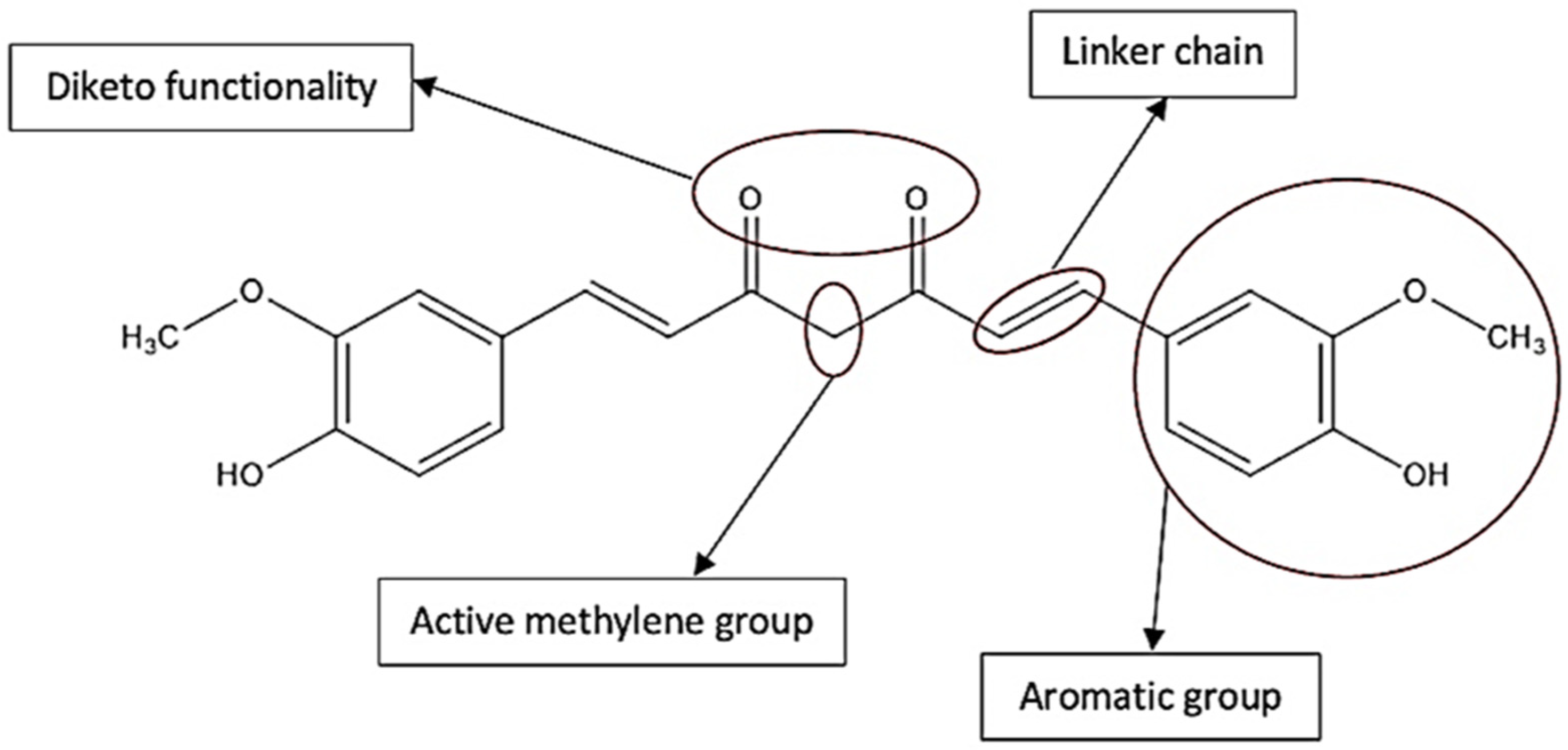
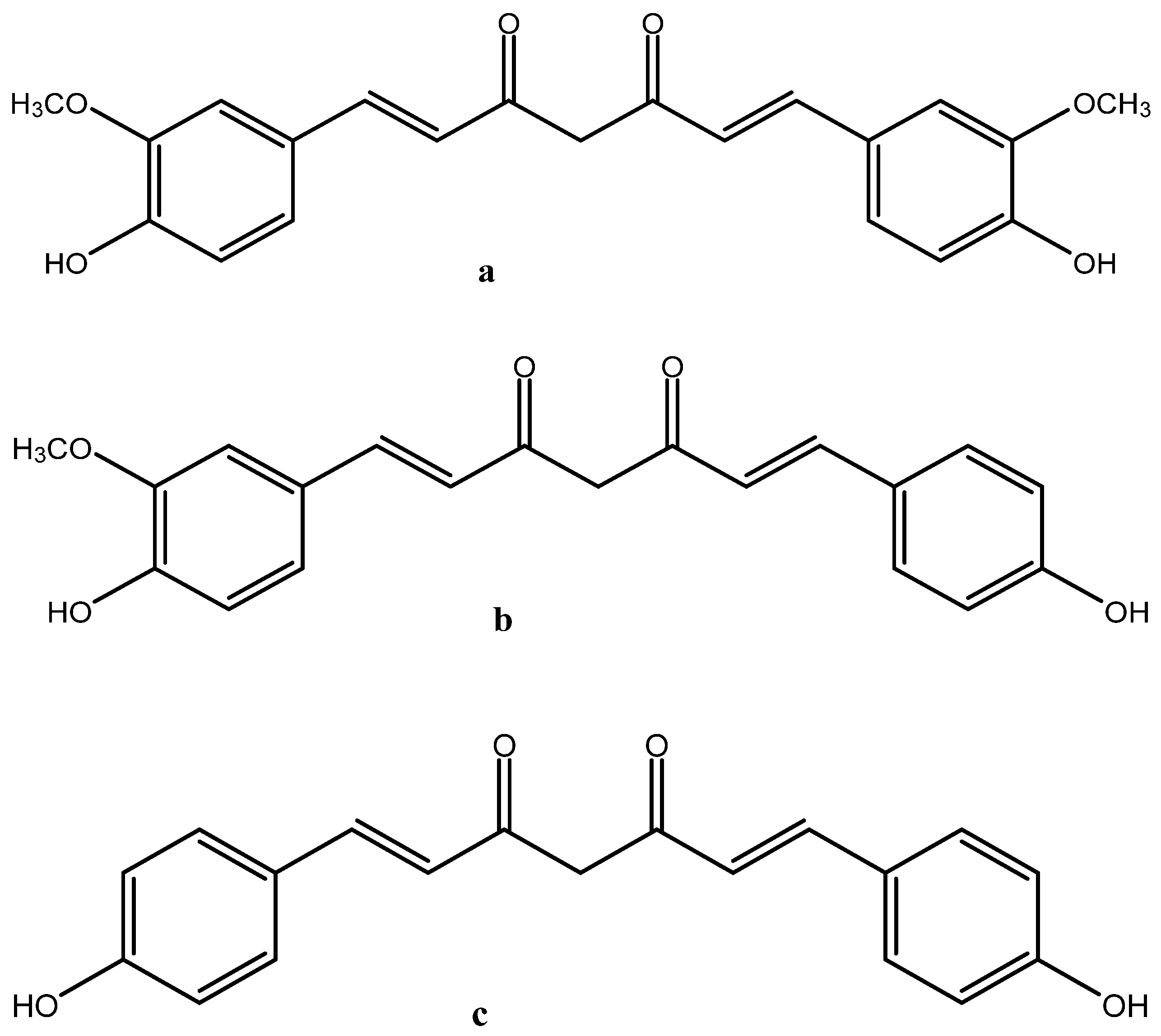

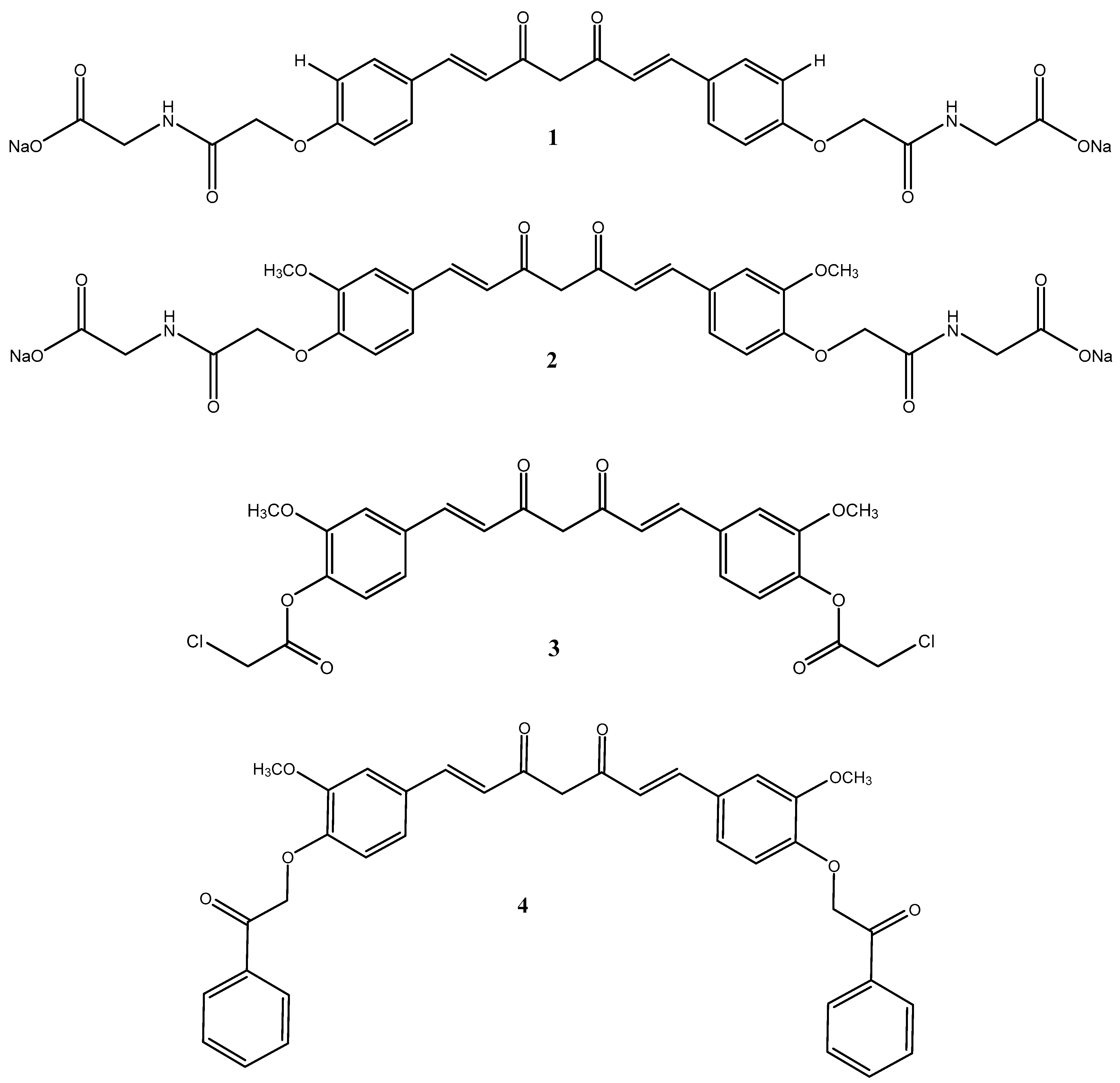
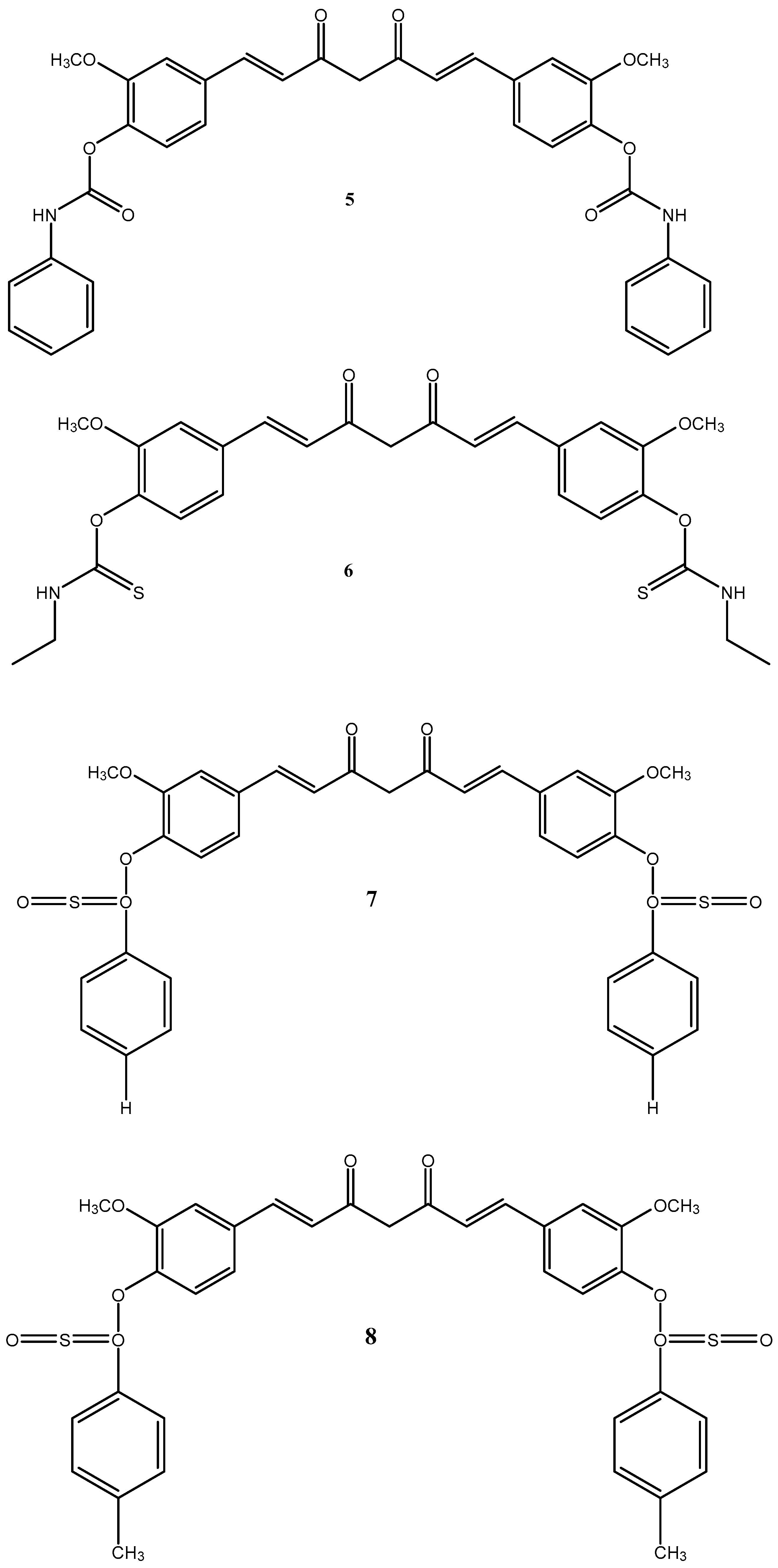
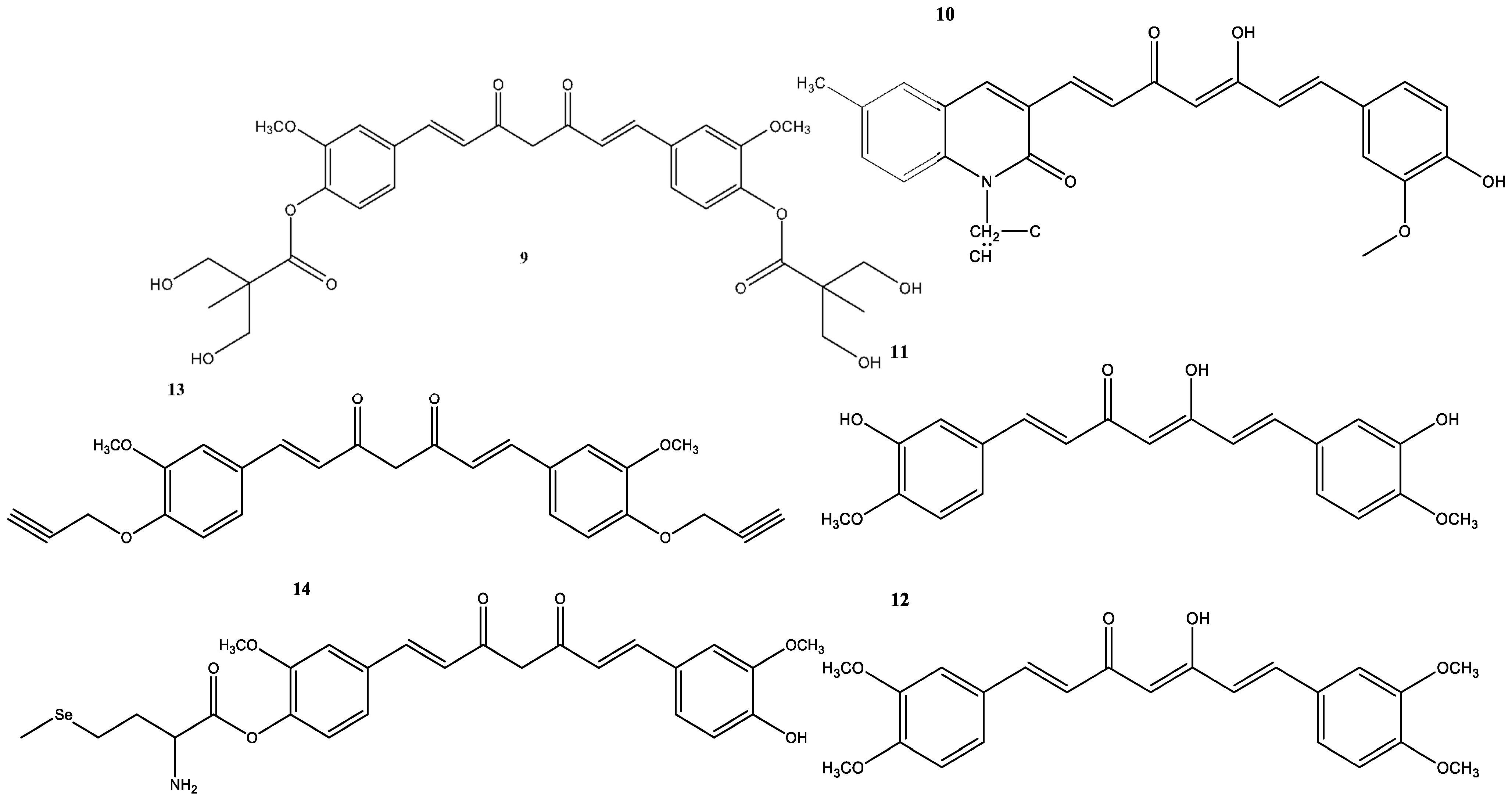
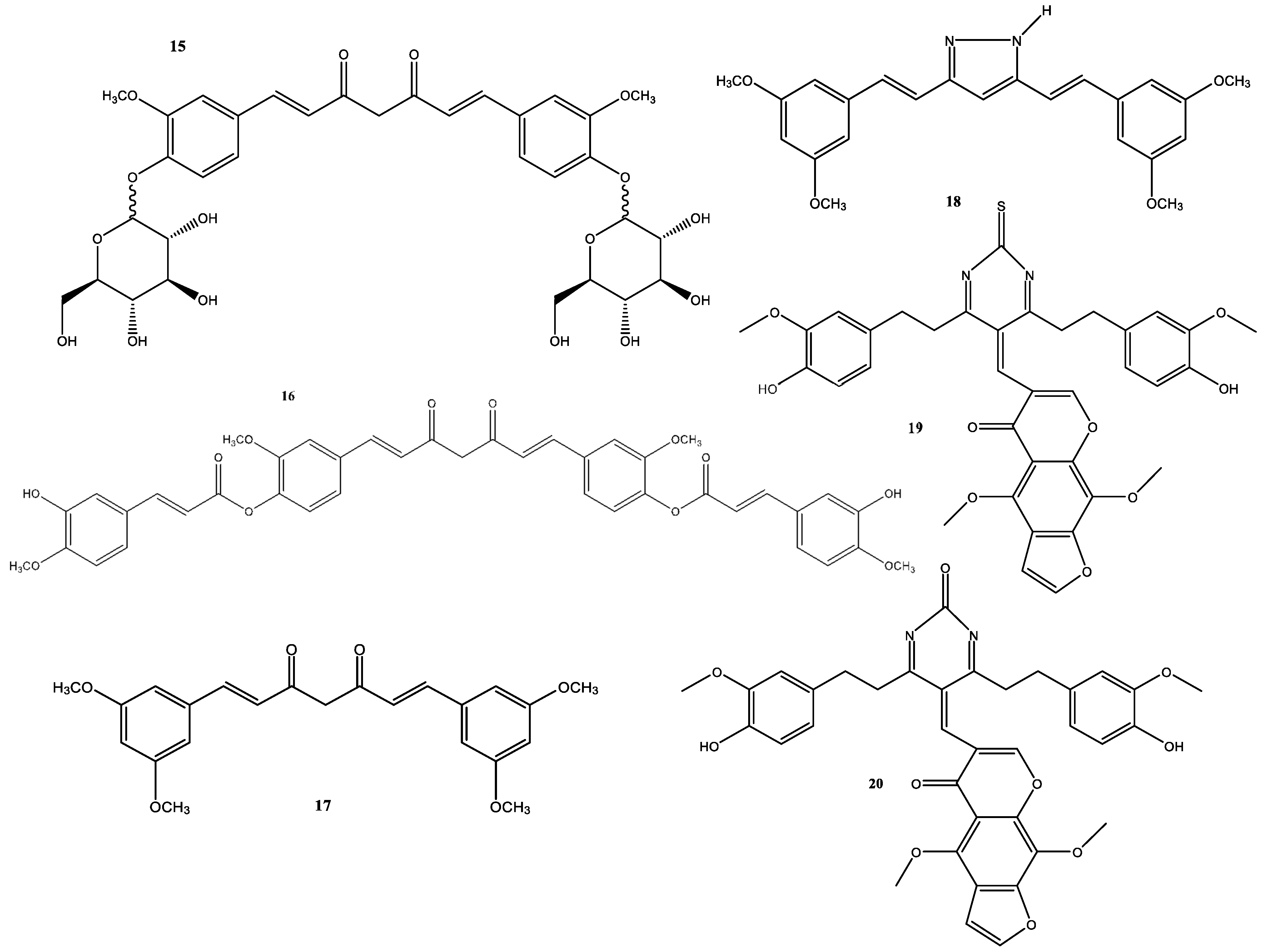
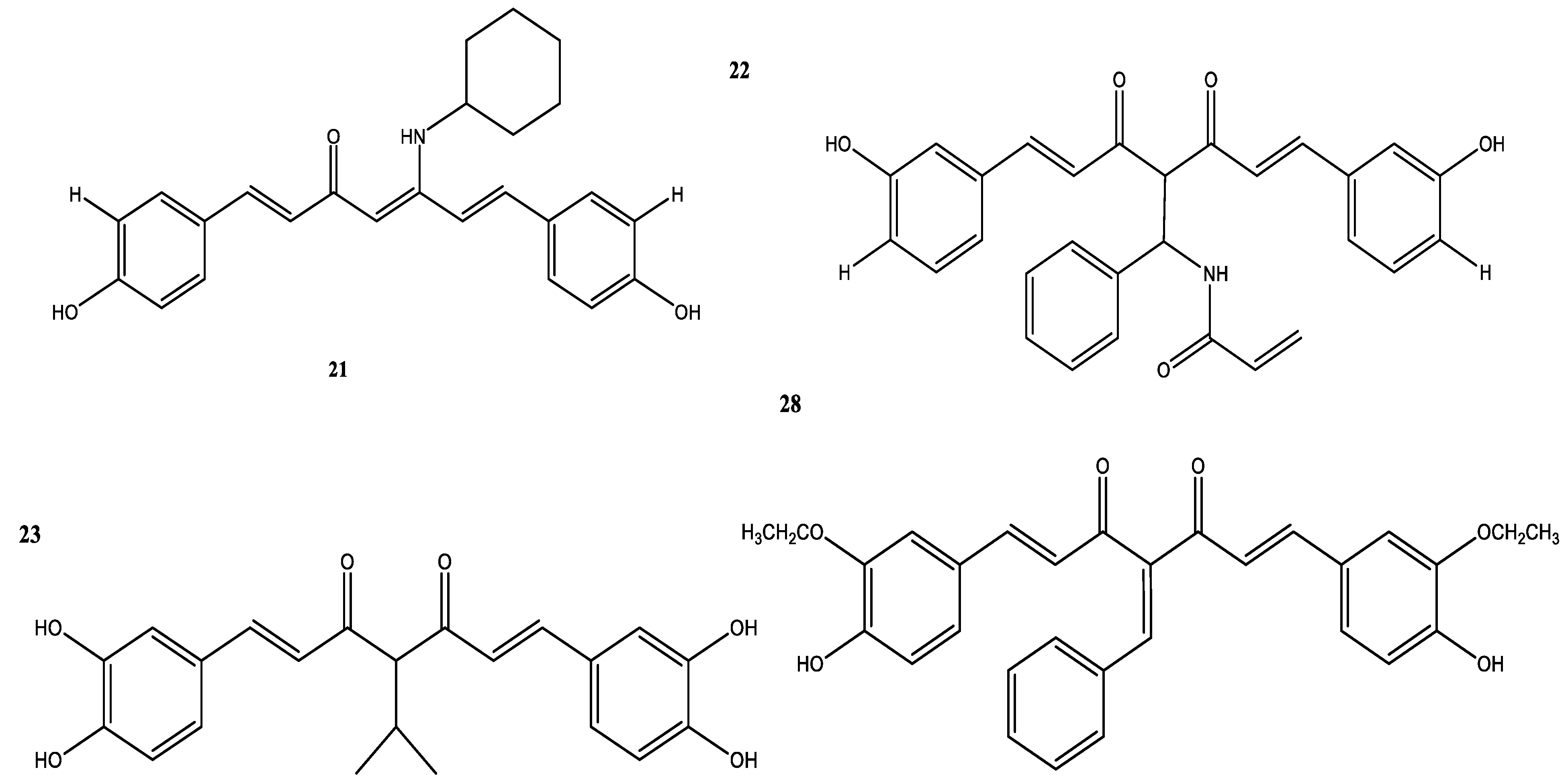
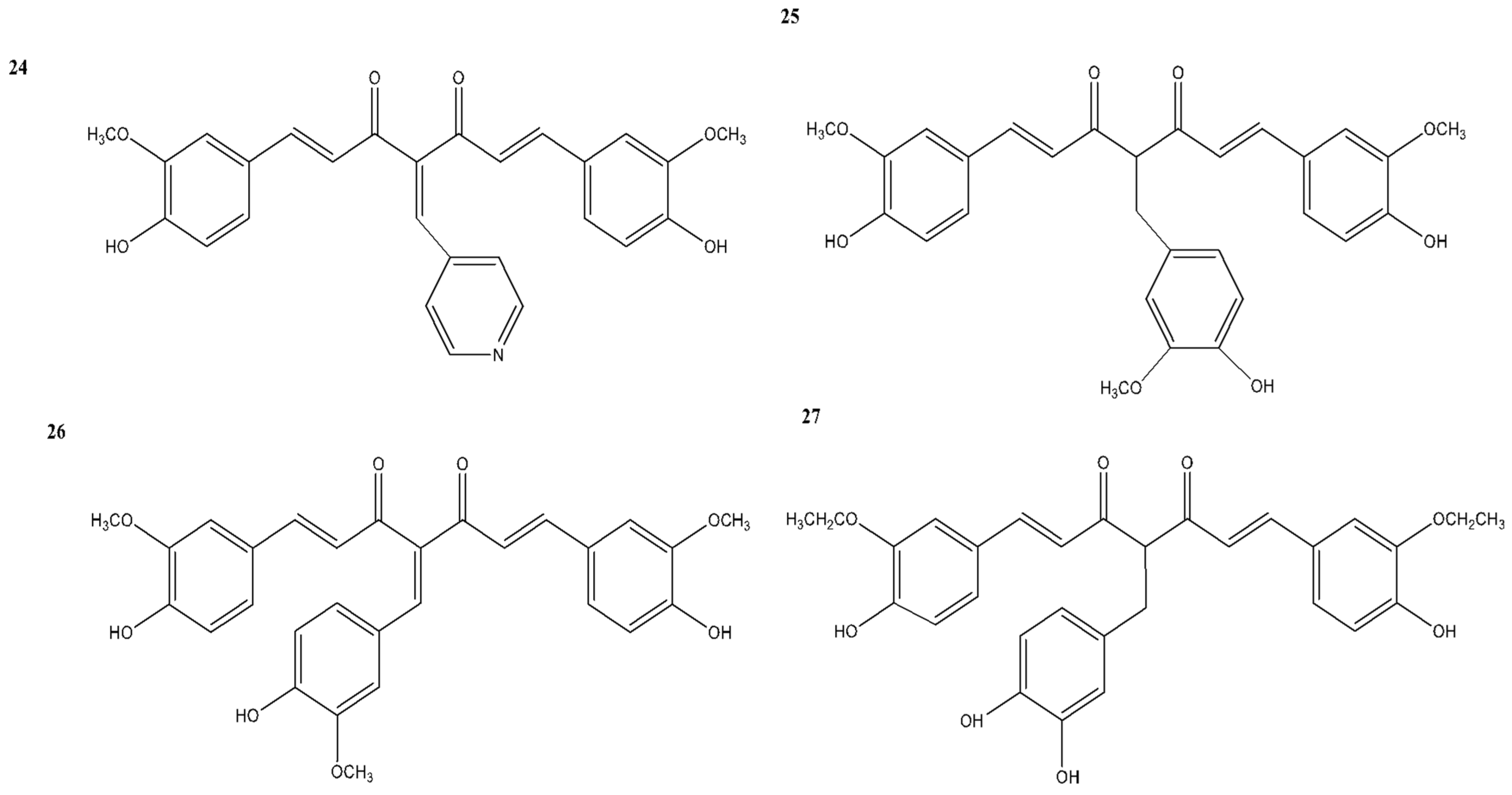
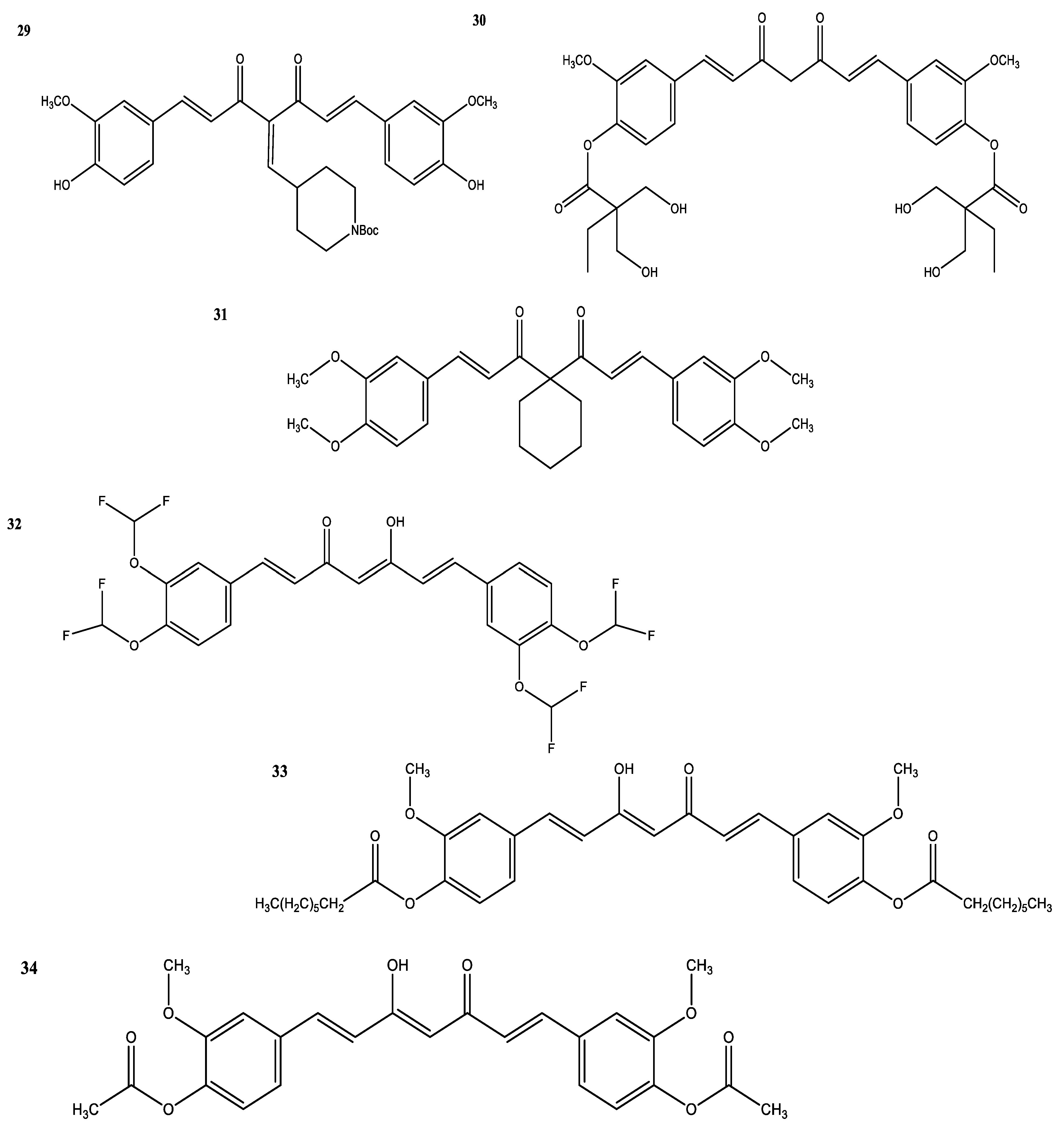
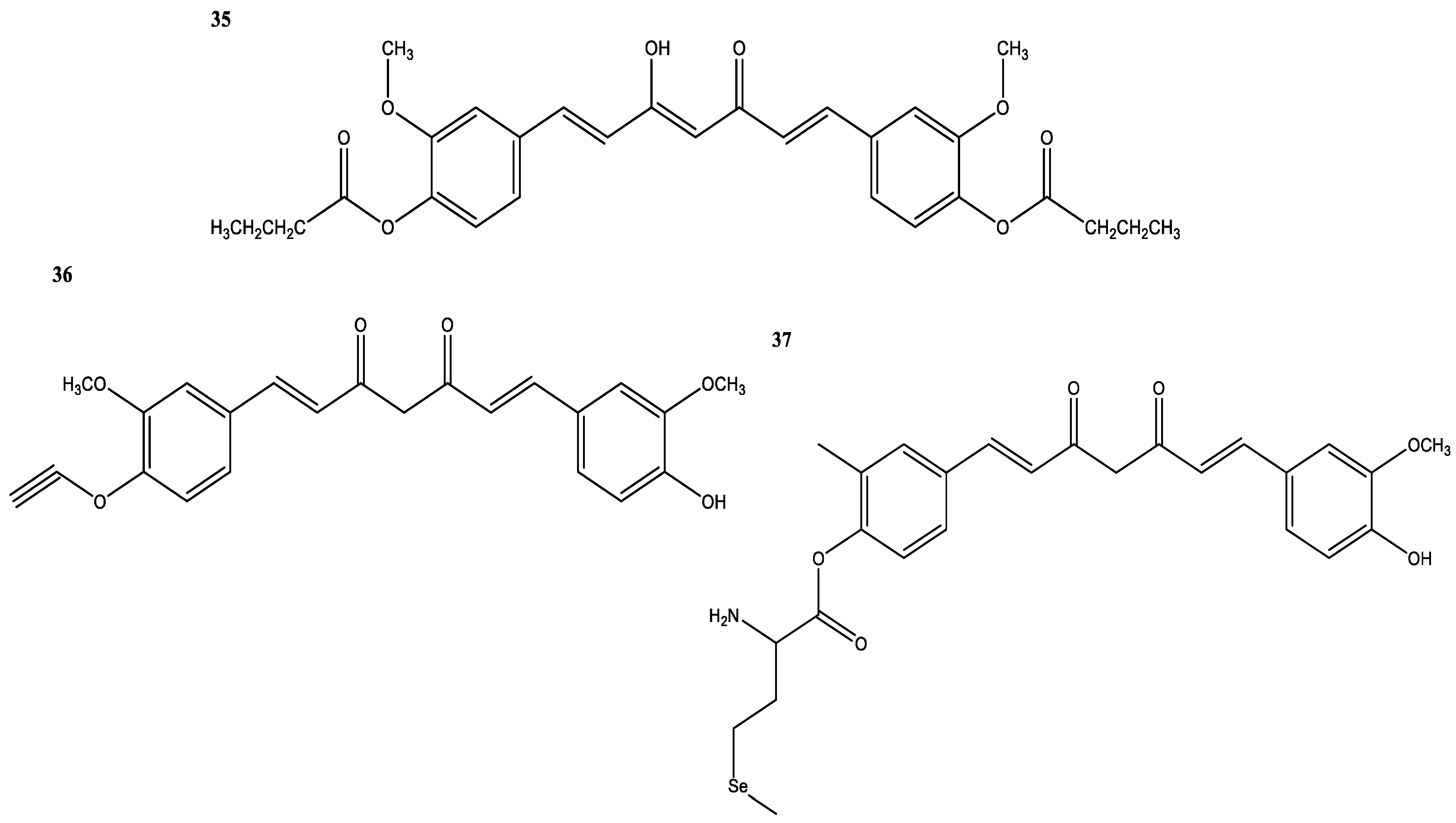


| Compound(s) | Biological Activity | Cell Line Tested (IC50 Value—μM) | References | ||
|---|---|---|---|---|---|
| Antioxidant | Anticancer | Anti-Inflammatory | |||
| 1 | – | + | – | HeLa—0.5 ± 0.003 | [1] |
| 2 | – | + | – | HeLa—0.5 ± 0.005 | [1] |
| 3 | + | – | + | Not reported | [2] |
| 4 | + | – | + | Not reported | [2] |
| 5 | + | – | + | Not reported | [2] |
| 6 | + | – | + | Not reported | [2] |
| 7 | + | – | + | Not reported | [2] |
| 8 | + | – | + | Not reported | [2] |
| 9 | – | + | + | MDA-MB-231—2.67 ± 0.18 HCT-116—3.91 ± 0.27 PC-3—3.90 ± 0.08 | [3] |
| 10 | – | + | – | A549—23.9 ± 2.5 MCF-7—36.2 ± 1.99 SKOV3—12.8 ± 0.21 H460—21.75 ± 0.55 | [4] |
| 11 | + | + | – | SKOV3—5.58 ± 2.0 | [5] |
| 12 | + | + | – | SKOV3—3.51 ± 0.74 | [5] |
| 13 | + | + | – | H460—3.4 ± 0.84 RH460—2.6 ± 0.25 K562—6.3 ± 0.95 K562 Doxorubicin—2.73 ± 0.61 | [6,7] |
| 14 | – | + | – | Hep G2—0.31 LX-2—0.62 SMMC-7721—0.81 MDA-MB-231—0.52 | [8] |
| 15 | – | + | – | HT29—41.56 | [9] |
| 16 | – | + | – | MCF-7—0.51 Hep G2—0.58 LX-2—0.63 3T3—0.79 | [10] |
| 17 | – | + | – | MCF-7 | [11] |
| 18 | – | + | – | Not reported | [12] |
| 19 | – | + | – | Hep G2—23 | [13] |
| 20 | – | + | – | MCF-7 | [13] |
| 21 | – | + | – | Caco-2—7.8 HT-29—4 EA.hy926—3.3 | [14] |
| 22 | – | + | – | GBM—0.87 GBM2—1.43 GBM3—1.45 GBM4—1.26 GBM5—0.92 GBM6—2.32 U373 MG—>5 U87 MG—0.38 U251 MG—0.33 | [15] |
| 23 | – | + | – | Not reported | [16] |
| 24 | – | + | – | K562 | [17] |
| 25 | – | – | – | Not reported | [18] |
| 26 | – | + | – | DLD-1—5.063 ± 0.09 | [19] |
| 27 | – | + | – | DLD-1—5.101 ± 0.11 | [19] |
| 28 | – | + | – | DLD-1—5.064 ± 0.12 | [19] |
| 29 | – | + | – | MCF-7—1.5 ± 0.7 | [20] |
| 30 | – | + | – | MDA-MB-231—5.37 MDA-MB-231—2.67 Doxorubicin-resistant MDA-MB-231—5.70 | [21] |
| 31 | – | + | – | Not reported | |
| 32 | – | + | – | 22RV1 cells 48 h—8.791 72 h—8.516 | [22] |
| 33 | + | – | – | Not reported | [23] |
| 34 | + | – | – | Not reported | [23] |
| 35 | + | – | – | 1.92 (%) | [23] |
| 36 | – | + | – | SUM149—11.20 MDA-MB-231—18.00 | [24] |
| 37 | – | + | – | MDA-MB-231—0.52 | [24] |
| 38 | – | + | – | MCF-7—73.4 | [24] |
| 39 | – | + | – | MDA-MB-231—EC50—0.42 | [24] |
| 40 | – | + | – | MDA-MB-231—EC50—0.78 | [24] |
| 41 | – | + | – | MCF-7 | [24] |
| 42 | – | + | – | SUM149—13.50 MDA-MB-231—15.00 | [24] |
| 43 | – | + | – | MCF-7—13.10 MCF-7R—12.00 | [24] |
| 44 | – | + | – | MCF-7—2.56 MDA-MB-231—3.37 | [24] |
| 45 | – | + | – | MCF-7—34.99 | [24] |
| 46 | – | + | – | MCF-7—5.80 | [24] |
Disclaimer/Publisher’s Note: The statements, opinions and data contained in all publications are solely those of the individual author(s) and contributor(s) and not of MDPI and/or the editor(s). MDPI and/or the editor(s) disclaim responsibility for any injury to people or property resulting from any ideas, methods, instructions or products referred to in the content. |
© 2024 by the authors. Licensee MDPI, Basel, Switzerland. This article is an open access article distributed under the terms and conditions of the Creative Commons Attribution (CC BY) license (https://creativecommons.org/licenses/by/4.0/).
Share and Cite
Kaur, K.; Al-Khazaleh, A.K.; Bhuyan, D.J.; Li, F.; Li, C.G. A Review of Recent Curcumin Analogues and Their Antioxidant, Anti-Inflammatory, and Anticancer Activities. Antioxidants 2024, 13, 1092. https://doi.org/10.3390/antiox13091092
Kaur K, Al-Khazaleh AK, Bhuyan DJ, Li F, Li CG. A Review of Recent Curcumin Analogues and Their Antioxidant, Anti-Inflammatory, and Anticancer Activities. Antioxidants. 2024; 13(9):1092. https://doi.org/10.3390/antiox13091092
Chicago/Turabian StyleKaur, Kirandeep, Ahmad K. Al-Khazaleh, Deep Jyoti Bhuyan, Feng Li, and Chun Guang Li. 2024. "A Review of Recent Curcumin Analogues and Their Antioxidant, Anti-Inflammatory, and Anticancer Activities" Antioxidants 13, no. 9: 1092. https://doi.org/10.3390/antiox13091092









